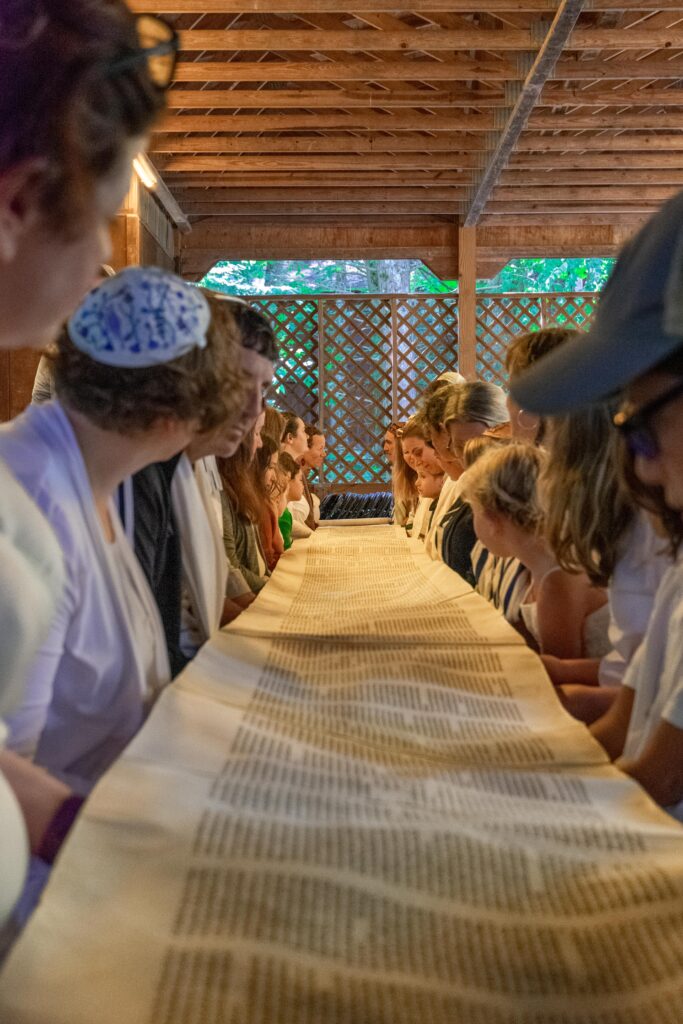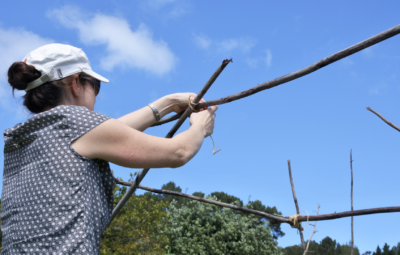
Rabbi Isaac Saposnik
Executive Director, Camp Havaya

When I was a kid, I remember the moment on Simchat Torah when the Torah scroll would be unrolled around the sanctuary. We would sit in the middle of the room with our parents carefully holding the parchment around us. Even as a child, I knew the rules: Don’t put your fingers near the letters. Make sure not to rip anything. Be careful not to drop it, lest you have to fast for 40 days. (It turns out that last one is a minhag — a custom, not a law. Phew!)
As a rabbinical student many years later, I found myself leading services for a Reconstructionist minyan in Jerusalem. We took the Torah out of the ark, and it was like nothing I had encountered in my Ashkenazi
world. Rather than a fabric cover, this was housed in a beautifully ornate metal holder. And instead of laying it upon the table to find the spot where we would begin our reading, the only way to prepare this Sephardi Torah was to reach in and roll it with my hands. My friends must have seen the look of panic on my face because one of them (I wish I could remember who!) leaned over and whispered: “It’s OK. Go ahead.” And so, with a fair bit of trepidation, I reached out with my bare hands.
It was a moment I’ll keep with me forever. The visceral power of holding Torah in my hands was surprising and inspiring. And I found — even if I didn’t yet understand it completely — that something so simple could, in fact, change the way we understand, experience and reconstruct tradition.
At Camp Havaya, we end each summer with a five-day Family Camp. This is a great opportunity for parents and children (and sometimes, grandparents and other family members, too!) to play, sing, laugh, learn, swim, climb, explore and have fun together. And it’s a chance to share meaningful Jewish moments with no prior knowledge required. In a weekend filled with all sorts of wonderful moments, one of the most beautiful always happens on Saturday morning. After singing and dancing our way through the first part of a family-friendly Shabbat service, I invite everyone to put their books and fidget toys to the side. They then move into two parallel rows with each person sitting knee-to-knee with the person across from them. And then, just as parents are beginning to wonder what’s about to happen, we undress the Torah.
I always start with the same instruction: “All you have to do,” I say, “is let the scroll rest on your laps.” Everyone starts to buzz, and parents get a bit of a panicked look, thinking about how their kids will behave. And then the Torah is right there in front of them … and they are, almost immediately, transfixed. They’re able to notice the intricacies you can’t see unless you’re up close: the faint etchings that help the sofer (scribe) write in straight lines; the ways letters are adorned or elongated, or columns justified; the way the pages are sewn together and often reinforced with “Band-Aids” on the back. We point out some of Torah’s “greatest hits” — the Ten Commandments, the Shema, the priestly blessing, the prayer we say when opening the ark — and discuss how the way the words are written in the scroll can add to the way we understand their meaning. Throughout, everyone is physically touching the parchment, and before they know it, it begins to touch them spiritually in return.
For kids, this is fairly simple; they are excited to learn, to show off their knowledge and to have an engaging prayer experience they didn’t quite expect. For adults, too, there’s something magical about being engaged in ways they didn’t anticipate. But even for those parents who have been with us for multiple summers, we watch them light up anew each year. There is an almost inexplicable sense of wonder and awe, which I think comes in large part from being able to do something that felt so inaccessible to them as a child (and, often, as an adult as well).


To do this sitting next to their own child(ren) inevitably brings a feeling of joy and pride to be passing down some sense of tradition, even if they can’t quite put it into words. And, if we’re completely honest, there are those for whom this is a deep moment of tikkun, of repair, for the sometimes negative, off-putting and detached Jewish experiences of their past (whether as children or adults, whether born Jewish or not).

When we first start to unroll the scroll, there is always a moment when, rather than letting us lay the Torah carefully on their laps, everyone raises up their hands as if they’re supposed to hold the Torah overhead. I used to think this was just logistical, but I’ve come to believe it’s actually much deeper. So many of us are taught from a very young age (whether explicitly or implicitly) that Torah is in the purview of professional Jews, standing on the bimah, only to be engaged with in the most sanctified of ways. So when we have the opportunity to hold it in our own hands, on a camp bench surrounded by our kids, we’re just not sure how to respond. And something inside us tells us, however wrongly, that we have to hold the scroll at arm’s length —as if it’s too holy for us to touch.
But our touch is exactly what makes it holy. For so many of us, the moments when we get to experience this holiness-making are too few and far between. So when they arise — whether at Simchat Torah or Family Camp or anywhere else — it’s up to us to grab hold of them, for ourselves and for our children. Lo bashamayim hee, the text says; “it is not in the heavens.” (Deuteronomy 30:12) We’re not meant to see the Torah as out of our reach, but rather, as “very close to [us], in [our] mouth and in [our] heart.” (Deuteronomy 30:14) And, of course, in our hands.
Learn more about Family Camp here.










